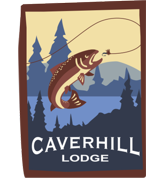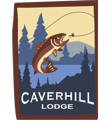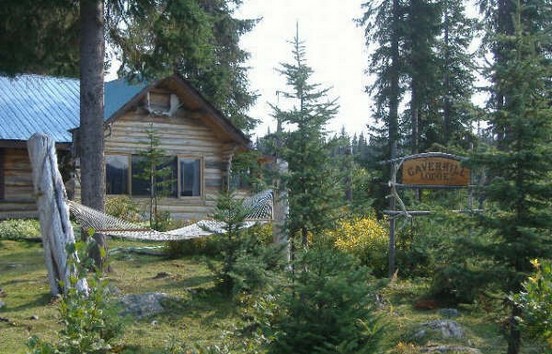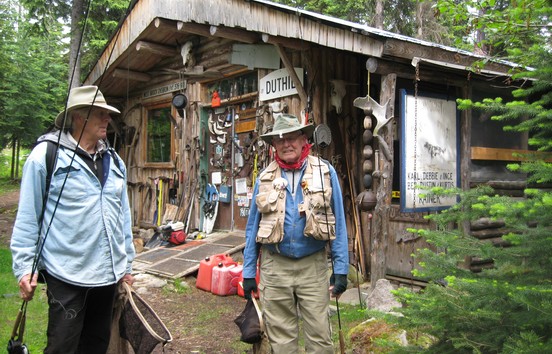CAVERHILL LODGE SHOW PLACE OF THE BONAPARTE PLATEAU
by Don Robertson
If you asked me to name the one outstanding item to be enjoyed at Caverhill Lodge, in British Columbia’s high country, I would have difficulty in choosing between the top calibre fishing and fine dining!
Caverhill Lake is located at an altitude of 4,600 feet on the edge of the interior’s Bonaparte Plateau and accessed either by floatplane or a remote logging road. Lodge guests have the opportunity to fish on 18 high level lakes, ranging from a few acres to over three miles long.
The waterways consist of shallow, reedy ponds surrounded by grassy shores, plus, some full-fledged mountain lakes with forested shores and deep waters. Although each lake is unique, all have one common denominator, prolific fishing for fighting Kamloops rainbow trout. These brightly coloured fish range in size from small pan fries to about three pounds.
Established more than 40 years ago, Caverhill Lodge has built up a reputation for its fishing, hospitality and gourmet dining. It began with the original builder and owner, Bus Ellis, and is being carried on by Larry and Marlene Loney, who bought the operation three years ago.
Caverhill’s fishing season is primarily from June to middle of September. Prime fishing occurs in the high country shortly after the ice goes out on the lakes and rivers, and ensures that the shallow lakes and rivers such as Mud, Spring and the Grassies, remain cool until the summer sun warms these waters, and sometimes adds a muddy flavor to the fish.
Marlene, who is the artistic creator of the American Plan gourmet fare, occasionally takes time off to cast a fly as a change from her kitchen and other duties. She claims it is possible “to come up with a whole group of guys and not see anyone,” while fishing on a lake. Eight to 12 guests is the lodge’s preferred capacity, although Marlene confesses they sometimes take up to 15 fishermen.
But, with the smaller number, it is easier to maintain Caverhill’s quality service.
Caverhill Lodge retains its remote, wilderness style by being located on the southeast shore of the lake, accessed only by boat or floatplane. When driving in, clients must arrange a pickup time at the landing on the lake’s southwest shore. The Caverhill Queen, a 20-foot, 50 hp jet-engined craft with either Larry, Marlene, or helper Jeremy at the helm, quickly covers the mile-long-trip across the lake.
During my brief stay, Marlene teamed me up with her nephew, Jeremy Windblad who was accompanied by the lodge dog “Bones,” for the 35-minute hike into Bramon Lake, where we fished while crossing to larger Triangle Lake. Equipped with a substantial box lunch, we set out about 1 p.m. to try our luck.
Accompanied by a father and son team from Bakersfield, California, we took a pair of boats across Bramon Lake. A black leech fly brought Jeremy success, and he had one trout for smoking Caverhill-style.
Arriving at the southwest corner of the lake, we went ashore and began the 10-minute portage to Triangle Lake. Triangle is just over a mile long, with a rocky, treed shoreline and waters to 80 feet in depth. Here, the “athletic” trout are bright silver and run up to two pounds. A cabin on Triangle Lake, at the start of the portage, provides shelter from stormy weather or as an overnight stop for avid anglers.
Winds play a factor on the larger lakes, as the prevailing breezes often sweep their length. Each boat is provided with an anchor to enable fishermen to cast without blowing ashore.
In two hours of fishing at the Boulders (while devouring Marlene’s tasty bag lunch), and cruising through the narrows into a mini-lake formed at the southwest end, we netted two nice 12-inch-long rainbows, which were quickly released. The California father-and-son duo of Bill and Mike Lazzarini, fishing along the shoreline, successfully boated a half-dozen rainbows, destined for the lodge smoker and packing for shipment home.
In addition to the major lake, the 132-foot-deep Caverhill, anglers have a choice of fishing Nomans, known locally as Mud Lake, Spring Lake, the two Grassies, Belcache, Keith. Malcolm, Christina, Beckworth, Malarky, Harbor, Stony, Day and both Bramon and Triangle Lakes. Caverhill’s brochure points out that the number of fishing lakes available, equated to the maximum number of lodge guests, results in a ration of one lake per fisherman.
Even casting from the lodge dock can bring results. Anglers often lay a dry fly onto the sunset dappled waters or cast from a boat anchored just a few yards from the lodge.
Caverhill Lake has an eight-trout daily limit, but anglers are encouraged to take only those fish they can use and to release the remainder.
Fishing Nomans (Mud) Lake as well as nearby Spring and the Grassies, a duo of anglers did well using primarily a blood leech fly backed by shrimp patterns and Tom Thumbs.
We lost count of the number of fish caught and released after a day’s fishing on Big Grassy Lake. We kept only four larger trout for the smoker, ranging from 12 to 17 inches. It pays to cast away from the shore into the deeper waters to attract the larger fish when casting on these shallow, reed-lined lakes, as the shoreline seems to be the domain of a myriad of pan-fries. On the deeper lakes the tree-shadowed banks hold the big ones, but not so here. Casting in the mouth of streams also provides great fishing action.
Articles From Local and International Newspapers
Articles by Brian Chan – Expert Fly Fisherman and Author
- Fly Selection for the Caverhill Lake Area
- The Quarry – Kamloops Rainbow Trout
- A Primer on Stillwater Fly Fishing Equipment and Tactics





